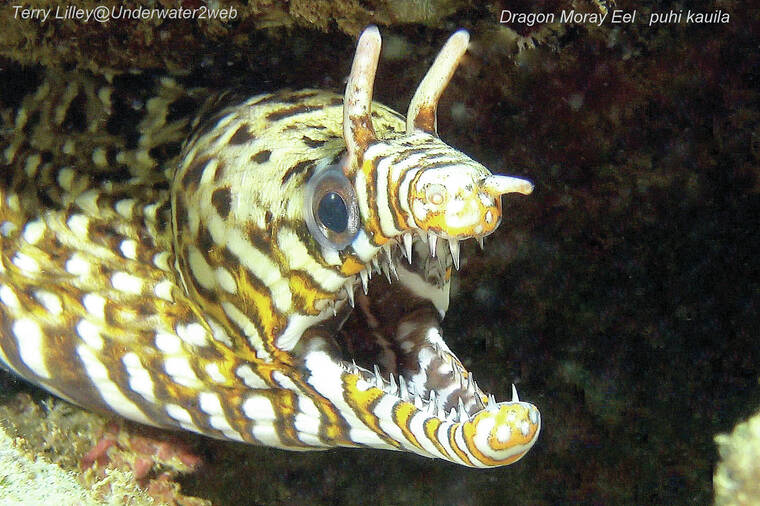While scuba diving in Palau, we came upon a 3-foot-long, speckled moray eel, and the divers with cameras lined up underwater to get a picture of it, while I just ignored the eel and kelp diving with the hopes of finding a giant humphead wrasse.
When we surfaced and got back on the dive boat, several of the divers were super excited about seeing the eel, as they said that was the first one they have ever seen.
One of the divers asked me why I did not want to get a video of it? My answer was, “Heck, I live in Hawai‘i and I usually see several species of moray eels on every dive, so it was no big deal for me.” For an entire two weeks diving in Palau, we only saw three moray eels!
In Hawai‘i, moray eels are called “puhi,” and we have 42 species that call Hawai‘i home. It is not uncommon for me to see five to 10 moray eels on an hourlong scuba dive. At Koloa Landing I shot video of eight different species on one dive. We have so many moray eels that one species, the tiger moray, only eats other moray eels.
Our moray eels range in size from the dwarf moray that only gets about 12 inches long to the giant moray that can get over 10 feet long. All of the morays are predators, and most have sharp teeth. The design of their mouth and teeth dictates what they feed on. The rare dragon moray has super sharp teeth and feeds on live, small fish, whereas the zebra moray has small rounded teeth for crushing crabs and sea urchins.
Most of our moray eels are active and feed at night, but a few species feed during the day, like the snowflake moray. The eels usually stay back in the caves and cracks in the reef, so you often just see their head sticking out with their mouth open, exposing their sharp teeth. As a general rule, these eels do not bite people, and their mouths are open so they can suck in water over their internal gills to breathe. When divers get close to the eels, they get nervous and breathe more, so their mouth gets even wider to suck in more water.
Hawai‘i has very unique marine life because we are so isolated in the middle of the Pacific Ocean. Our fish species probably arrived in Hawai‘i floating on surface currents driven by the wind. Some baby fish can last in the open ocean for months, while others die along the way. This means that only a select few species made it all the way to Hawai‘i from other Pacific islands, and the moray eels arrived in large numbers.
Giant grouper and snappers eat moray eels, but those big fish never made it to Hawai‘i or arrived in very small numbers. Large, 300-pound groupers feed on moray eels, and these giant fish are only seen occasionally way up in the Northwest Hawaiian Island chain. We do have the roi here in Hawai‘i, which is a peacock grouper, but it is not large enough to feed on the moray eels.
The lack of large predator reef fish here in Hawai‘i has allowed the moray eels to thrive. In the Philippines, Palau, Indonesia, Tahiti and Caribbean, there are large populations of big grouper, so they have very few moray eels. Hawai‘i has more eels than anywhere else in the entire Pacific Ocean.
You can see all of the puhi species in action in my underwater documentary movies I shot at Sharks Cove on O‘ahu and Koloa Landing on Kaua‘i up on my educational webpage at underwater2web.com. I will have a new movie out soon that is all about Hawaiian moray eels. If you sign up on my YouTube channel at Underwater2web, you will get all of my new movies for free as soon as they are released.
•••
Terry Lilley is a marine biologist living in Hanalei. He is co-founder of Reef Guardians Hawai‘i, a nonprofit on a mission to provide education and resources to protect the coral reef. To donate to Reef Guardians Hawai‘i, go to www.reefguardianshawaii.org.




